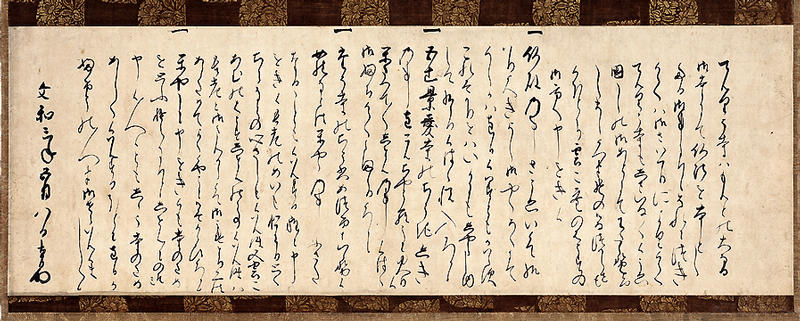尼・東峯惠日置文
- 南北朝時代
- 14c
- 紙本墨書
- H-31.4 W-92.3
南北朝時代 14世紀 文和3年(1354)
紙本墨書
縦:31.4cm 横:92.3cm
惠日は如大尼を開山とする尼五山第一(臨済宗)の景愛寺第五世の東峯惠日だとわかる。一つ書(箇条書)の消息体で,冒頭の箇条は追書(追伸)の書式(字下り)である。文和3年(正平9)5月,惠日尼は景愛寺住持職を華林恵厳尼に譲ったが,その際,念願の景愛寺仏殿の造営(寄進)の成就を第一,門徒らは恵厳尼の擁護,女性では不慣れだから景愛寺の重書(重要書類)は他に寄托した。なお,恵厳尼の終命あるいは引退の際は天龍寺雲居庵坊主(長老は無極志玄,塔主は春屋和尚)に相談せよ。また,門徒志願の輩があっても結局は惠日尼に不孝(不逞)する輩だから入寺させるなという四か条にわたる置文(遺言書・定書)である。門徒や外護者らに遺したものだが,有事の際の依頼先は決めていたらしい。
追記(あるいは序説)ともいえる冒頭の条文は,天龍寺内の紛議が上裁(御さばくり)によって解決したのが喜ばしい。天龍寺は同じく仏光派の大寺で夢窓国師のお寺である。そこで喜びを国師の弟子の同寺雲居庵主に伝え,景愛寺に対する厚誼を求めている。むしろ書き出しの文章でもあり,置文は天龍寺雲居庵主に後事を托したものとも言える。
江戸時代,この置文は如大尼の文(他に両三ある)に添って伝来したので,古筆家など惠日の考証に難儀をしている。尼門跡研究家の大塚実忠師のご示教により,私は景愛寺住持第六世東峯惠日尼と断定した。なお,天龍寺に対する上裁(御さばくり)などの解説は省略する。
足利尊氏・直義兄弟の抗争,南朝軍の京都進出で無極和尚が天龍寺住持に再任したり,景愛寺末寺の正脈院を拡充したりした高師泰・師直兄弟(一説に師直・師泰兄弟)が誅殺されるなど,政情混乱が天龍寺や景愛寺に波及していたのがわかる。新史料である。 (永島)
消息(しょうそく)
手紙のことで、特にかな文体のものをいいます。消息は普通一枚の紙に書きました。消息文を書いた紙を本紙といい、大切なことだけを書きました。その他のことは持参する者が口述したといわれています。男性は漢文の消息文を書きましたが、次第に和様化されていきました。女性はかな文の消息を書きました(かな消息)が男性もかな消息は書きました。その場合日常使っている簡略された漢字をまぜて書かれたものが少なくありません。往信に返信を書いて返した消息を勘返状(かんぺんじょう)といいます。
尼・無外如大かな文
中臣祐定・藤原為家勘返状
読み書き下し
てんりう(天龍)寺ハもんと(門徒)の大なる
御寺にて仏法を本とし
たる御事にて候。それにつき
候てハ御さバくり(上裁)により候て、
てんりう寺もしさい(子細)なく候うゑ、
国し(夢窓国師)の御あとにてわたらせをハ(御
し(坐)まし候へば、その御なつかしさも
候ほどに、雲ご(居)庵のばうず(坊主)の
御方へ申をき候。
一仏殿の事、ざうゑい(造営)候て給
ハり候べきよし、御やくそく(約束)にて
候しかバ、惠日く(供)養どもかハらず(かゝわらずカ?)、
こればかりをバいかにもじやうじゆ(成就)
して給り候はゞ、悦入候べく候。
一五辻景愛寺のぢうぢしき(住持職)
の事、恵ごん(巌)ちやうらう(長老)にゆづり候。
かまへて〃〃しぜん(自然)の事候はゞ、
御ふち(扶持)候てたまは(給)り候べく候。
一たう(当)寺のちう(重)書あづけまいらせ候。
女性などはかやうの事もぶさた(無沙汰)
なることも候ハんずる程ニ申
をき候。長老のめい(命)もおは(終)り、とく(特)
ぢう(住)などの心ざし(志)も候ハん時、又雲こ(居)
あむのばうずしぜんの事候ハん時ハ、
長老と御だんかう(談合)候て御うけとり候へば、
あらためて、よく候やうに御はからひ候べく候。
一かやうに申をき候も寺のため
を思ふゆえにて候。しぜんに(望)のぞミ
申候人候とも、しじう(始終)寺のため
あしく候ハんずるほどに、惠日が
ふけう(不孝)の人は御せういん(承引)候ま
じく候。
文和三年五月八日 惠日(花押)
Catalogue Entry
by Toho E'nichi
Nambokucho period, 14th century (dated May 8th, 1354)
Hanging scroll, ink on paper
Height, 31.4cm; width, 92.3cm
E'nichi was the 5th generation head of the temple Keiaiji (Rinzai sect), which was founded by Nyodai and was the premiere convent temple of the Five Principal Convent Temples. This text by E'nichi, an itemization in letter form, has the introductory section written in the ottegaki writing style in which the lines begin one character lower than normal. In the 5th month of 1354 (Bun'na 3), E'nichi had transferred the responsibilities of head nun of Keiaiji to Karin Egon, and on that occasion, she wrote this 4-article testamentary statement. The 4 items discussed include: an earnest petition for the completion of the construction (donation) of Keiaiji's Buddha Hall; for Egon to assist her disciples, as she is an inexperienced woman; to deposit the important papers of Keiaiji with another (to consult with the priest of Ungoan, Tenryuji upon Egon's retirement or death), and to not allow those who are disobedient (insubordinate) to enter the temple, even if they ask to be made disciples. While this statement was conveyed to both her disciples and her outside patrons, it seems to have had a specific addressee.
The opening passage, which can be seen as either a postscript or as an introduction, expresses her happiness at the resolution of the conflict within Tenryuji by imperial decision. This temple is the great temple of their same Bukko school and was founded by Muso (1275-1351). She conveyed her congratulations to the disciple who was the head priest of the Ungoan of Tenryuji and asks for their kindness towards Keiaiji. Thus this introductory passage, or testamentary statement, entrusts the matters after her death to the head of the Ungoan of Tenryuji.
In the Edo period, this testamentary text was handed down with texts by Nyodai (with 2 or 3 others), and this hindered scholars' investigation of calligraphy by E'nichi. According to Dr. Otsuka Jicchu, a scholar of writings by Buddhist nuns, this was determined to be the 6th head of Keiaiji, Toho E'nichi. Here an explanation of the imperial decision regarding Tenryuji, etc., will be omitted.
When the armies of the Southern Court advanced upon Kyoto as part of the dispute between the Ashikaga brothers, Takauji and Tadayoshi, Mukyoku was reinstated as the head priest of Tenryuji, and death sentences were meted out to the brothers Ko-no-Moronao and Moroyasu who had expanded the Shomyakuin branch temple of Keiaiji. These and other such events show how Tenryuji and Keiaiji were swept up in the political disturbances of the day. This letter provides new historical material for research. FN
